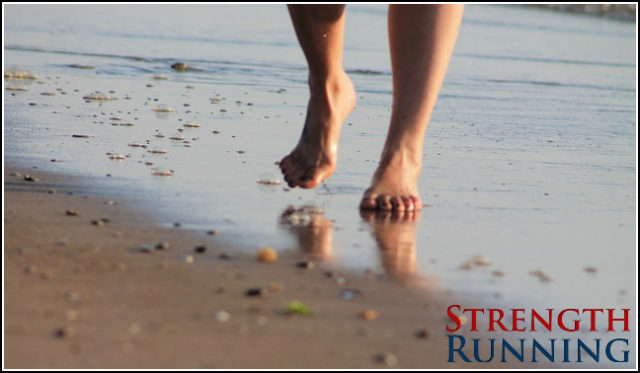If you were a baseball pitcher, would you prevent shoulder injuries by pitching with your arm in a cast?

I hope you answered, “No, Jason. That sounds ridiculous.”
Because it IS ridiculous! To be a good pitcher, you need strength, efficiency, some talent, and great form (not to mention a lot of practice).
Putting your arm in a cast, sling, or other restrictive device would alter how you throw, preventing valuable proprioceptive feedback and hampering your performance.
So why in the world do we cram our feet into restrictive shoes that change our foot strike, alter our gait, and reduce our awareness of how our feet are hitting the ground?
The truth is that we do this all the time without thinking twice. And it often results in chronic problems with running injuries.
An interesting study discussed in Tread Lightly (fantastic book about footwear and injuries) found that motion control shoes do not control motion and actually cause injuries!
That’s because the more structured a shoe is, the more it inhibits normal movement and promotes inefficient, poor running form:
- A high heel-toe drop makes it easier to aggressively heel strike and over-stride
- High-density foam on the insole (a “roll bar” or the medial post of shoe) doesn’t prevent over-pronation
- Aggressive arch support further weakens the foot muscles
These problems are made even worse by wearing high heels, restrictive dress shoes, and rarely walking or exercising barefoot.
The result? Weak feet and higher cases of shin splints, plantar fasciitis, Achilles tendinopathy, and other injuries not just limited to the lower legs.
And while I’m not suggesting you start running barefoot or in zero-drop shoes all the time, there’s a valuable middle ground.
Rather than dogmatically believing this is an “either/or” choice, we can instead be more strategic with our shoe choices.
How to Build Your Foot Core
Current research has indicated that strengthening the small stabilizing muscles around the arch and plantar fascia can improve ankle stability and balance – but it’s often neglected.
So I invited Matt Ferguson, the founder of AFX, on the Strength Running podcast to discuss several topics around foot strength:
- How to build strength in these oft-neglected muscles
- Mistakes to avoid and myths that can derail your progress
- The value of being a “cautious minimalist”
- How to choose shoes that are right for you personally
You can listen on iTunes or, if you have an Android device, on Stitcher.
Links and Resources:
- Ankle Foot Mobilizer
- The Vibram Five Finger lawsuit for making false claims
- How to transition to minimalist running shoes
- Jason’s collection of shoe reviews (and why I do NOT recommend shoes)
- The benefits of trail running
- How to run strides
- Anatomy for Runners by Jay Dicharry
- Video demonstration of the AFX system
- The type of shoe my daughters wear
If you struggle with ongoing plantar fasciitis, weak or unstable ankles, and chronic foot pain then working on your foot core is one path to relief.
You may also find it helpful to structure your running to prioritize health and getting stronger further up the kinetic chain (start with these strength exercises).
I hope you enjoyed our latest episode of the SR podcast. A review on iTunes would be just incredible!